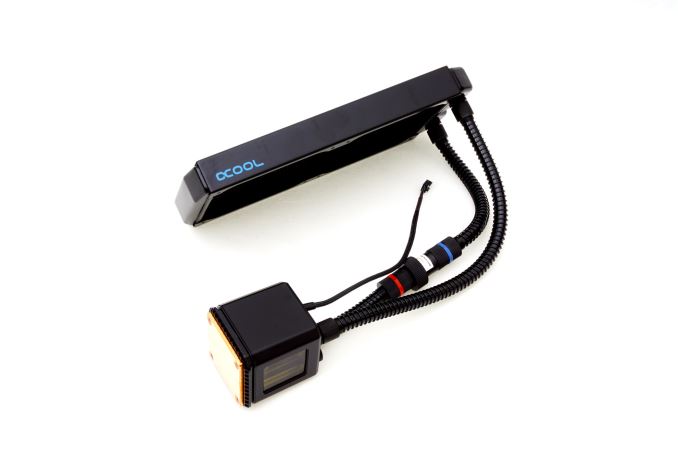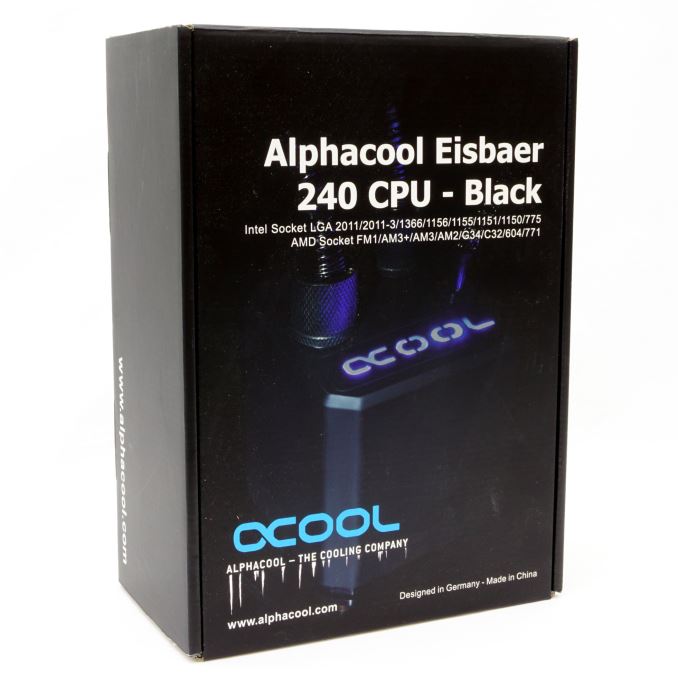The Alphacool Eisbaer 240 CPU AIO Liquid Cooler Review
by E. Fylladitakis on August 1, 2016 9:00 AM EST- Posted in
- Cases/Cooling/PSUs
- AIO
- Water Cooling
- Cooler
- Alphacool

When liquid cooling became a trend in the 90’s, many companies were founded focused on the design and supply of PC-specific liquid cooling systems. One of these companies was Alphacool, a German manufacturer that diversified into producing liquid cooling systems for industrial and medical applications as well.
Introduction
Perhaps the biggest issue of liquid cooling is complexity, requiring quite a bit of extra effort and attention from the user. For custom loops this was certainly true, even when complete kits were supplied by most manufacturers, as the installation alone is much more complex than that of a simple air cooler. The relative safety and simplicity of all-in-one (AIO) liquid cooling systems does lure those who want a liquid-based cooler with the installation straightforwardness of an air-based cooler. However, AIO solutions are relatively inflexible, and some hardly perform better than high end air-based solutions.
In this review we are having a look at Alphacool’s latest product, the Eisbaer. The Eisbaer, which stands for “polar bear” in German, is a modular AIO liquid cooler that Alphacool designed for those that wish to combine performance and simplicity with future upgrades and flexibility. Alphacool has designed four versions of the Eisbaer that all share the same block/pump assembly but have different radiators and fans. The Eisbaer 120, 240 and 360 come with one, two and three 120 mm fans respectively, while the Eisbaer 280 comes with two 140 mm fans. For the means of this review, Alphacool supplied us with the Eisbaer 240, the dual 120 mm fan version. Although the concept of modular AIO liquid coolers is not new, Alphacool’s liquid cooling parts have had a good reputation, leaving us curious about how their first AIO liquid cooler will perform.
Packaging & Bundle
Alphacool supplies the Eisbaer in a dark cardboard box with relatively simple artwork printed on it. It is very sturdy and the cooler is protected inside a cardboard shell and covered in nylon bags, providing more than enough protection during transport.
The bundle accompanying the Eisbaer 240 is almost typical and limited to the necessary mounting hardware, two “Eiswind” 120 mm fans, an adapter for connecting both of the fans onto one 4-pin header and two doses of thermal compound. It is interesting to point out that the thermal compound is Gelid GC Extreme, a relatively premium thermal paste. The Eiswind fans are PWM compatible, with a sleeve bearing engine and a maximum speed of 1700 RPM.












69 Comments
View All Comments
ikjadoon - Tuesday, August 2, 2016 - link
You're behind. :( Already a 120mm rad with 2 fans is both 5C cooler and 0.1dB quieter than your Noctua NH-U14S.http://www.hardocp.com/article/2016/02/11/arctic_c...
FWIW, I also have a NH-U14S. Noctua buddies! :D
ikjadoon - Tuesday, August 2, 2016 - link
Nope. You are stuck in 2014. :( Gen5 Asetek is very good.5C cooler than the NH-U14S and 0.1db quieter. Maybe has other flaws...but it's not noise!
ikjadoon - Tuesday, August 2, 2016 - link
Forgot the damn link:http://www.hardocp.com/article/2016/02/11/arctic_c...
ikjadoon - Monday, August 1, 2016 - link
LOL. Using water-cooling on a CPU? You all gobbled up the marketing; you still believe in in 1990s ATX case design.GPUs need the water, not the CPU. 250W+ on load, using 9cm fans? Average load temps in the 70s with overclocking and overvoltage? Right, yes, put the water cooler on the CPU. :p
Abandon ATX cooling assumptions; it was meant for cooling Pentium 4's and 3.5" spindle disks.
wylie102 - Monday, August 29, 2016 - link
From what I've read you are right about this. My question would be - given that air CPU coolers vent/radiate their hot air into the case, as do graphics cards (open air designs at least) would it not be beneficial to have an AIO liquid cooler drawing in air from the case (it being warm shouldn't affect the CPU cooling too much as like you said, most units are more than capable) and venting it out of the case?Would this not provide a benefit to the temp of the case and therefore the cooling abilities of the graphics card (particularly if running SLI)? And doesn't it make sense to have the CPU do this given that cooling options are much more widely available for them and at less of a premium than GPU water cooling?
Hxx - Monday, August 1, 2016 - link
AIO coolers are still very much needed these days especially in a smaller form factor where air flow is not as great as in a larger case. I personally think that air coolers have reached their EOL. There is no need for a big chunk of metal to sit on top of your motherboard especially when nowadays you can buy an excellent AIO that is reasonably priced, quiet, cools better, and looks aesthetically more pleasing, and its painless to install.there used to be a time when AIOs used to be so much more money, kind of like how it is now if you want to jump into a custom loop. There is a price to performance ratio that needs to be addressed. But as far as closed loops, some of them are almost just as inexpensive as an air cooler and providing much more benefits.
retrospooty - Monday, August 1, 2016 - link
I dont think so... When talking about building a new system, we are talking Intel Skylake CPU. Anything running a Skylake is already cool as hell. There are some great small form factor cases and premade systems, as small as Lenovo Tiny Desktop that are running quad core i5 and i7 desktop processors. They are a little over 1 inch thick and dont even get hot. You would only need it if you had both a really thin/small case AND you were significantly overclocking it... Now if you bought a good enough motherboard to significantly overclock it, what case are you getting that is too small to fit a decent air cooler, but big enough where it can still fit a decent power supply that can handle significant overclocking and even a small AIO water cooler? Where is the radiator in this setup? Is it outside the case?ikjadoon - Tuesday, August 2, 2016 - link
...there are strong ITX overclocking motherboards. You don't need 1kW to OC; even SFX PSUs are in the 700W range, more than enough for dual-GPU OC + 8-core CPU OC.retrospooty - Tuesday, August 2, 2016 - link
I get that, but still what is the point? If you are overclokcing to that level, you probably arent using a tiny case. If you are, that fine, but again I ask - Where is the radiator in this setup? Is it outside the case?Sushisamurai - Sunday, August 7, 2016 - link
I'm running a tri-fire and 6core CPU. I should have a custom loop on the GPU's, but... whatever, they're too old now to drop that much money into them. Full load is close to 1000W - it's potentially a lot of heat, but radiator's are in the case, with a lot of airflow. GPU's hit 80 degrees and CPU's @60.